As soon as I walk into any gym, I start critiquing other lifters. I can't help myself. "Those are some great half-reps, buddy," or "Lady, if those dumbbells were any lighter they'd float away." Sometimes, it's just, "Pal, I have no idea what the Christ you're trying to do."
Obviously I don't say these things aloud, or I'd spend more time fighting than lifting. One of my rules is I never give unsolicited advice. Sometimes this rule tortures me—especially when I see mistakes with the bench press.
Why is the bench so important to me? Well, I spent several years competing in this particular lift as the captain of a traveling team that participated at meets throughout New England. I'm not one to do anything half-assed, so I did my research, read books, watches videos, and experimented with different methods in preparation for my contests. My work paid off in many official lifts more than double body weight—and in one strange contest, where I benched my body weight for 29 reps.
I spent hours at bench contests watching hundreds of lifters making thousands of attempts. I saw the following mistakes, and many others. This is my list of the major crimes and how to correct them. Fix each one to bring you closer to fulfilling your quest for a big bench, and move on to more pressing matters.
1 / Crazy Legs
If you want to press heavy weight, start with a solid base and incorporate your whole body. I've seen guys straining for another rep with their feet kicking like they're being strangled. Even worse are those who put both feet up on the bench. Unless you're practicing to walk a tightrope, there's absolutely no benefit to that position.
Here's how to build your base: After you lie back on the bench, bring your feet straight back toward your head, to the point where your heels are about to come off the ground—but no further. Your heels should stay in contact with the floor throughout the lift.

If you've got long legs, your butt may tend to come off the bench. You can avoid this by widening your feet. On the initial drive off your chest, drive your heels through the floor and hold that position until you rack the weight.
2 / Bent Forearms
Where you grip the bar determines which muscle groups will have the most influence on your lift, and which ones will get worked. Obviously your grip should be balanced and identical on both sides, using the power rings as a gauge. You may generate more power from your chest or your triceps, but at least initially, you should start out with a placement that uses both equally.
Here's how to determine that placement—and you will need someone to help you with this:
Have your helper stand either directly behind your head or directly in front of your feet. Lie back on the bench and take a balanced grip on an empty bar. Lower the bar to your chest and hold it there. Now have your helper tell you whether your forearms are exactly vertical and perpendicular to the floor. Ideally, your hands should be directly over your elbows. If you hands are flaring out (which is often the case), narrow your grip.
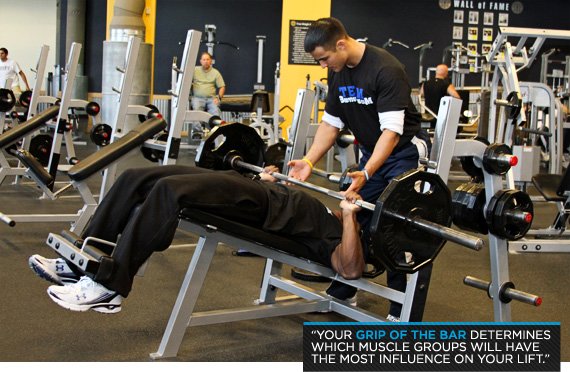
Now that you're properly aligned, you can make slight alterations, but I'm talking about an inch or two at most. If you believe most of your power comes from your chest, you can widen your grip. If you feel like the triceps are your big movers, you can narrow your grip slightly.
Do not use a false, or "thumb-less," grip. It's dangerous, and it also tends to force your elbows in tight to your body, making your front delts and triceps do most of the work.
3 / Shrugged Shoulders
When you lie on the bench your shoulders shouldn't be up by your ears. In the shrugged position you're not getting the full benefit of your pec strength, and you take your lats completely out of the lift—yes, your lats assist in your bench press.
During the lift, flex your lats and drive your shoulders down toward your hips while squeezing your shoulder blades together. This should create an arch in your lower back, but your butt should always stay on the bench. Only your upper back should be pressed hard into the bench. Always look straight up, and do not press your head into the bench. This could cause a neck injury.
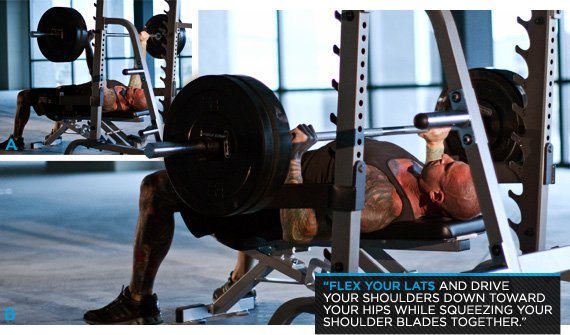
4 / Sagging Wrists
When you grip the bar, don't let your wrists sag back. The bar should remain directly in line with your forearms. Allowing your wrists to hang could lead to wrist problems. More important in the short term, it means the bar isn't in line with the sources of your power.
Need a visual cue? Hold your wrists tight as if you were punching a heavy bag.
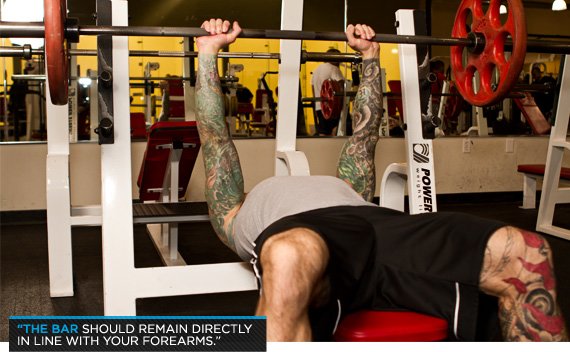
5 / Partial Reps
Who said it was OK to stop six inches above your chest? Are these the same people parking two feet from the curb?
The bottom portion of the bench press is where your pecs are most heavily activated. If you don't touch the bar to your chest, you're cheating your pecs out of a lot of good work. Sure, it's the most difficult portion of the lift. That's the point.
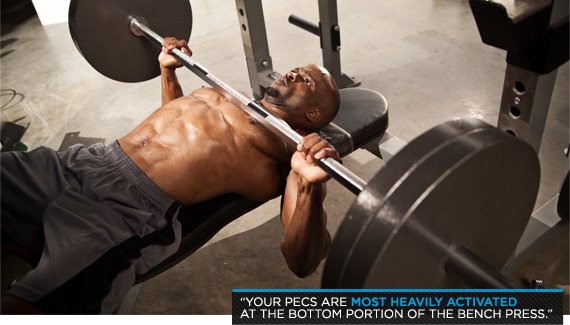
If you're doing these partial reps to inflate your numbers, be advised: Any rep that doesn't both touch your chest and end with complete unassisted lockout is not a rep. This means that you can't claim it when a fellow gym rat asks, "So how much ya bench?"
It's true that partial bench reps are acceptable in certain training programs, but that's beyond my jurisdiction for this article. We're talking the standard bench press here.
6 / The Chest Trampoline
Thankfully, I don't see this as much as I used to, but back in the day, guys were bouncing the bar off their chest like it was a bell-ringing contest. It's just another form of cheating, it's counterproductive, and you better believe it's dangerous.
I knew a guy who never benched without bouncing. Then he entered his first contest, where he had to pause with the bar on his chest. His pec ripped like an old gym towel.
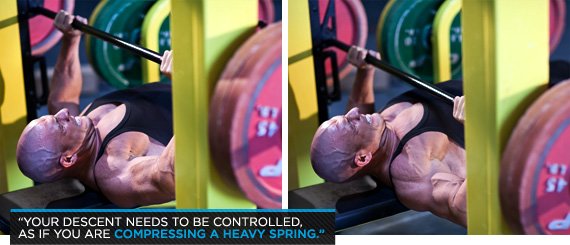
A new version of the chest trampoline I still see is a lot guys dropping the bar on the descent and then coming to a quick stop just above the chest. They cheat themselves out of the negative portion of the lift, which is just as effective in building muscle as the positive portion.
Envision it this way: Your descent needs to be controlled, as if you are compressing a heavy spring. When the bar touches your chest, the spring releases upward, powering you past the sticking point.
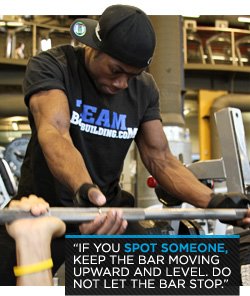
7 / Too Much Weight
This is a chronic problem in the weight room. It takes all my strength not to shout, "Are you benching, or are you assisting your spotter with upright rows?"
If you're doing a set of eight with a weight you can only get to lockout on two reps, lighten up, buddy. One or two assisted reps, after you perform at least five on your own are all you should need for assistance.
And if you're spotting someone, don't let the bar stop. Always keep the bar moving, upward and level.

No comments:
Post a Comment